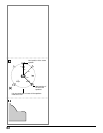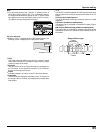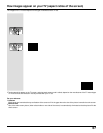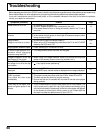
65
Note
•
It is recommended that the “I PAL 60” is selected at the “6
NTSC Disc Output” when a PAL TV is connected; however,
the images shown below will appear on the TV screen. Black
bars appear at the top and bottom parts of the TV screen.
(The picture may be compressed vertically.)
•
I/P/B
The MPEG 2 standard adopted for DVD uses the following 3
picture types for the coding of each picture (frame) on the TV
screen.
I:I-Picture (Intra coded picture)
This is the standard picture type, and each picture is coded
separately.
P:P-Picture (Predictive coded picture)
This picture type is computed on the basis of a past I-Picture
or P-Picture.
B:B-Picture (Bidirectionally-predictive coded picture)
This picture type is computed by comparing the previous and
subsequent I-Picture or P-Picture. It has the lowest volume of
information.
For your reference:
•
When the “2 On” is selected at the “5 Still Picture Display”, the
following screen is displayed in the still picture mode;
•
Field
Half of the video information (video signal) in a frame is called
a field. With conventional TV systems, a signal frame (a single
screen) consists of two fields.
•
Field still
Only one field (half of the video information) is displayed on
the TV screen, so the apparent resolution is low. However,
there is no blurring on the screen.
•
Frame
Individual images in a video or on the TV are called frames.
•
Frame still
The two fields are displayed, alternately, on the TV screen, so
the image is blurry. However, the image quality is better than
field images.
Still
(P)
Example: P-Picture
BBPBB
Predict
Predict
General Picture type
I
. . . . . .
Speaker setting


















